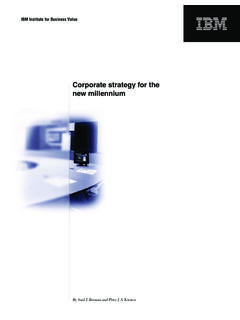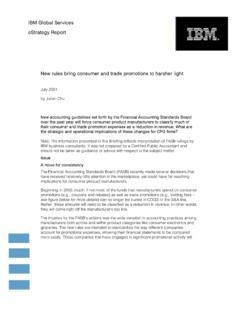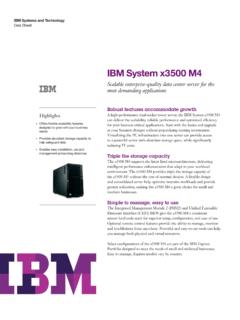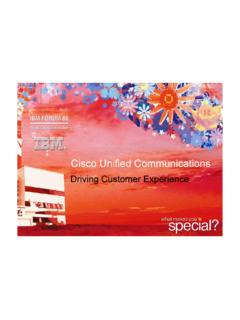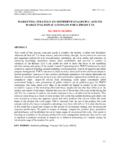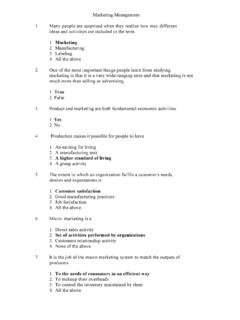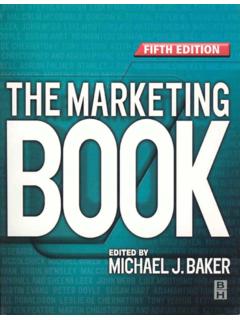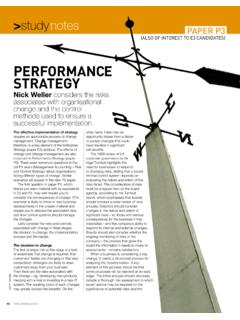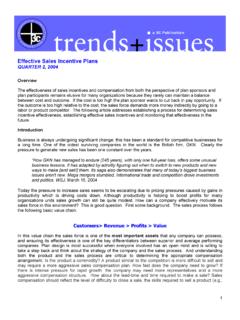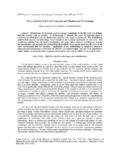Transcription of insurance strategy consulting - IBM
1 IBM Global Services insurance strategy consulting strategy consulting helps companies transform the way they do business. We help our clients achieve competitive advantage through a fusion of business, customer and technology strategies and an explicit linkage of critical issues to actions and results. We bring our clients the resources of IBM Global Services, the largest services company in the world, and the first-hand operational experience the IBM Corporation has gained over the course of its ten-year transformation. Below is an example of our insights and work in the insurance industry.
2 PRODUCT COMMERCIALIZATION FOR INSURERS: BRINGING PRODUCTS TO MARKET QUICKLY AND EFFECTIVELY The Issue: With the insurance industry facing ongoing consolidation, combined with increasing commoditization of core products, there is increasing emphasis on developing new products that innovatively meet customers' evolving and diverse financial needs. insurance companies are facing challenges in this environment, in terms of developing and bringing new products to market in a quick and effective manner. These challenges put increasing emphasis on developing integrated financial services capabilities and on the separation of manufacturing and distribution organizations.
3 Product development and commercialization challenges escalate as it relates to moving products from distinct manufacturing organizations into integrated distribution channels. Our Perspective: While many insurance organizations face challenges in the core part of their product development process, we have found that many of their issues lie in two related areas. The first area is the existence and alignment of insurance strategy consulting 2 product development with an articulated market and product strategy . Many organizations proceed with product development without a clear idea of what they are trying to accomplish in terms of their market and product strategy .
4 The second area is product commercialization capabilities. Organizations have difficulty bringing products to market effectively, in terms of adequate education and marketing materials to support transition into the channel, as well as creating the appropriate channel structure given the nature of the product and its stage of development in the market. Case in Point: A leading insurer had difficulty effectively launching new innovative products into its existing integrated distribution channels, resulting in disappointing sales levels.
5 The company needed a product commercialization model to support its three independent manufacturing organizations and diverse in-house and third-party wholesale and retail distribution channels. A joint IBM- insurance company team diagnosed the product development issues as related to commercialization efforts. Although the effort started within one of the product manufacturing organizations, it quickly became apparent that this was an enterprise-wide issue. The team defined the foundation of the commercialization model across the enterprise, including the manufacturing and distribution organizations.
6 They then outlined the specific management process steps associated with the new commercialization model, followed by the development of detailed implementation road maps. As a result, the insurer was able to transition to a new operating model with an understanding of specific actions, timeframes, and accountabilities. The new product commercialization model has allowed the insurer to enhance its product commercialization across the enterprise, provide a more seamless transition of products from manufacturing into the integrated distribution channels, and bring products to market in a more timely and effective manner.
7 CHANNEL OPTIMIZATION: HOW INSURERS WILL COMPETE IN A NEW DISTRIBUTION DYNAMIC insurance strategy consulting 3 The Issue: Until recently distribution power in the insurance industry has been concentrated into captive and independent insurance agents. While these two channels still represent 70-80 percent share of the net premiums written, the fastest growth has been in non- insurance specialized channels such as banks, wire houses, and independent financial planners. This trend is being driven by two primary factors: 1) traditional channels have been extremely expensive to support, comprising on average 60 percent of operating expenses; and 2) consumers are interested in obtaining un-biased financial advice from agents not tied to a specific carrier.
8 Manufacturers are struggling to define their value in this changing world. Our Perspective: As the third-party, multi-channel model continues to gain traction, insurers must increasingly fight for shelf space with independent distributors. insurance manufacturers are struggling to define new value propositions that are focused on value added support services to the distributors, and innovative competitively priced products. Insurers must be selective in their focus because supporting all segments is simply not economical.
9 Insurers pursuing multiple channels should understand which distribution support services can be standardized and customize only those services that are economically warranted. Understanding the performance management changes required to alter distribution behavior is another critical factor for successfully competing in the new distribution dynamic. Case in Point: A leading insurer had internally separated into manufacturing and distribution businesses to improve operational efficiencies, exploit new opportunities, and more effectively allocate resources.
10 Its IT environment was comprised of multiple distribution support tools contributing to cost inefficiencies and complexities from a manufacturer's perspective. The company needed a strategic and operational support model for its broad and varied distribution channels. A joint IBM- insurance company team developed a view of the distributor's essential needs from a carrier across the key stages of distribution support. The team then correlated the channel specific capabilities with those that could be shared across channels. Then current IT capabilities were mapped to business requirements to identify significant gaps and or opportunities.
